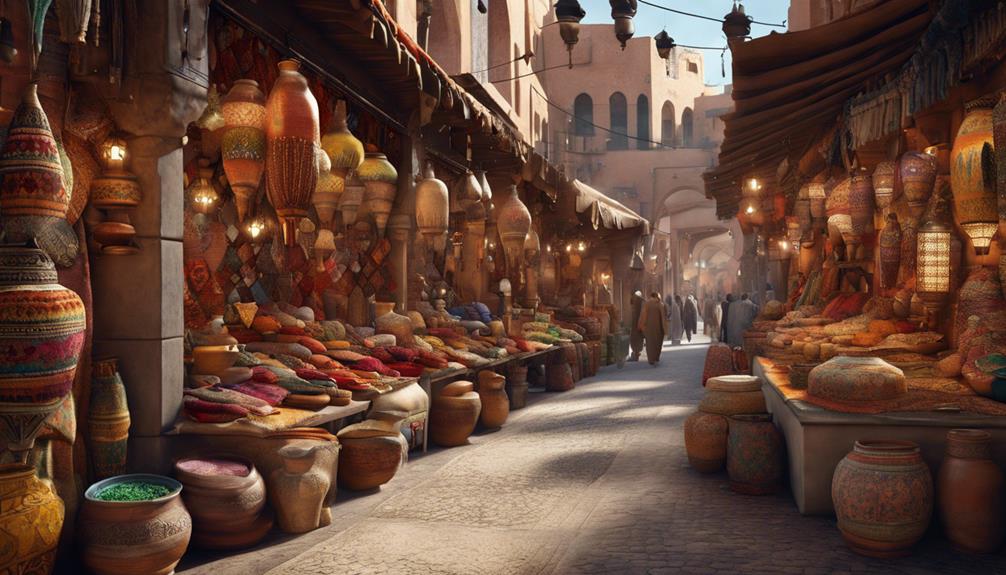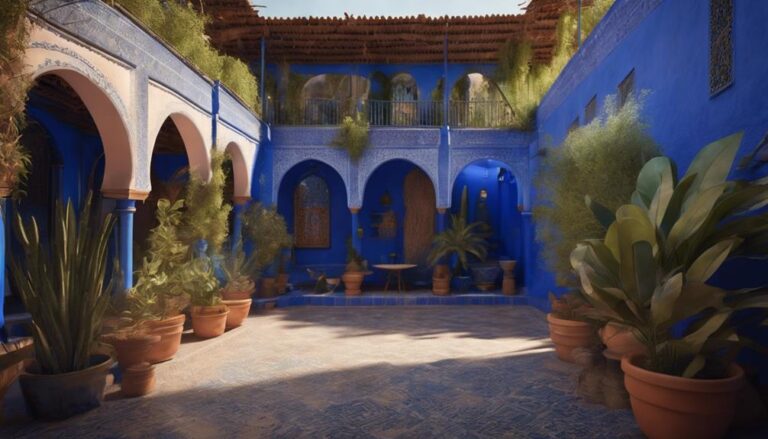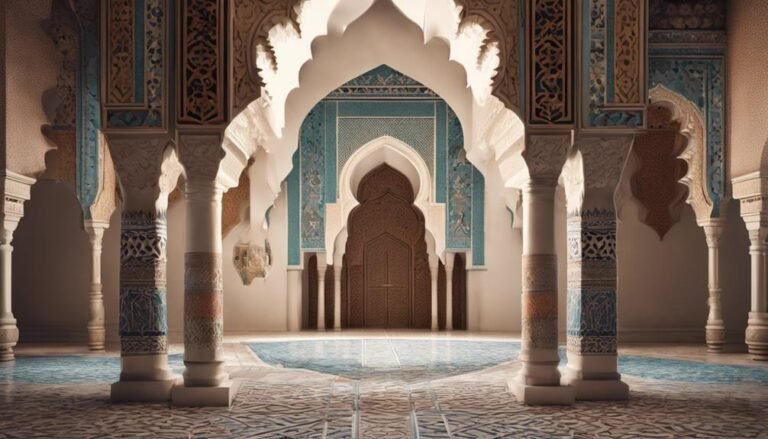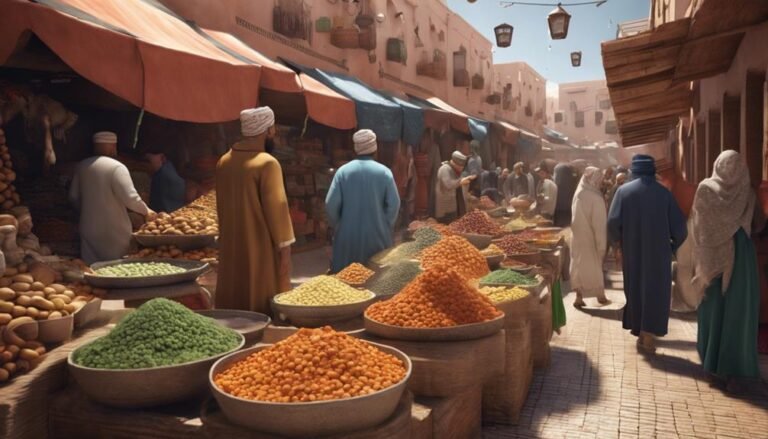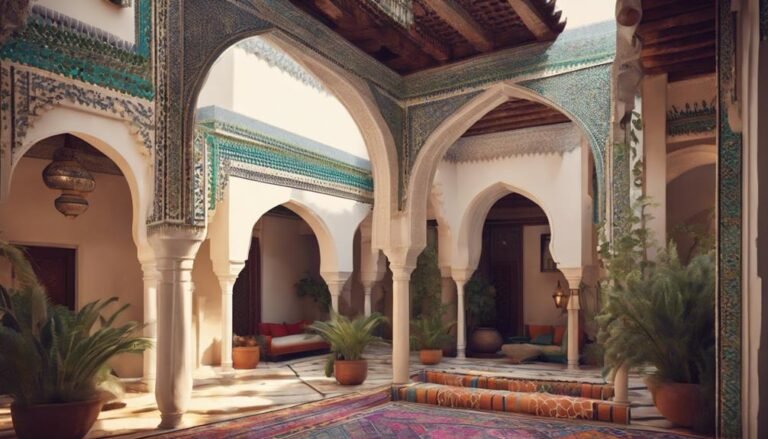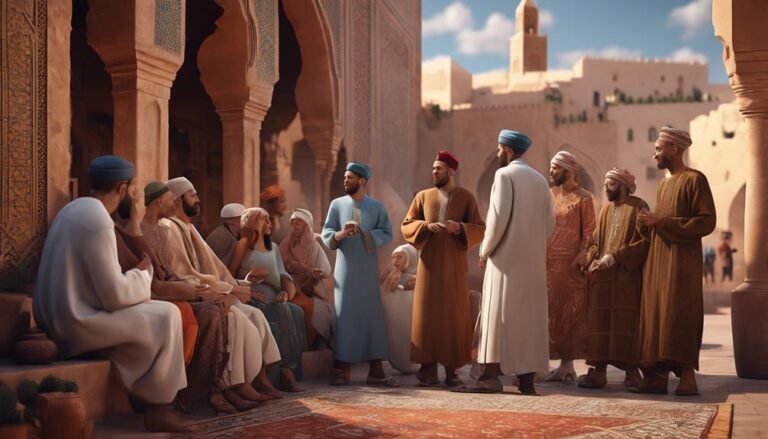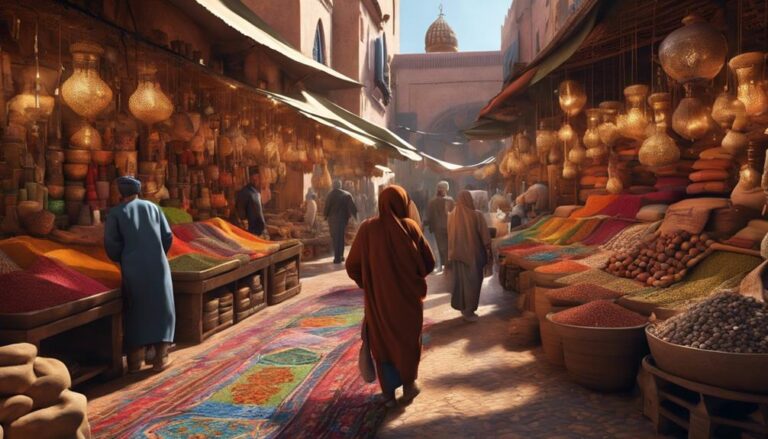Immerse yourself in the vibrant Moroccan bazaars, where ancient trade routes converge to offer a rich cultural tapestry. These bustling marketplaces are essential hubs of commerce and tradition, showcasing a diverse array of exotic products and traditional crafts. Engage in the art of haggling with skilled local artisans, savor the tantalizing flavors of Moroccan cuisine, and appreciate the significant role these bazaars play in the local economy. Each visit to a Moroccan bazaar is a unique experience filled with history, culture, and sensory delights, inviting you to discover more about this enchanting world of commerce and tradition.
Key Takeaways
- Moroccan bazaars are vibrant marketplaces shaped by historical evolution and cultural influences.
- They offer diverse traditional crafts, exotic products, and intricate designs reflecting Morocco's rich heritage.
- Haggling is an essential skill in bazaars, involving polite negotiation and friendly banter for better deals.
- These hubs of trade and cultural exchange contribute significantly to the local economy and artisanal traditions.
- Bazaars play a vital role in preserving Morocco's cultural identity, supporting local artisans, and fostering unity.
Origins of Moroccan Bazaars
The origins of Moroccan bazaars can be traced back to ancient trade routes that crisscrossed the region, fostering a vibrant marketplace culture. Historical evolution has shaped these bustling marketplaces, influenced by centuries of trade interactions with various civilizations. From the Berbers to the Romans and Arabs, each culture left its mark on the development of these bustling hubs of commerce.
Cultural influences are deeply embedded in the essence of Moroccan bazaars, reflecting the diverse heritage of the region. The intricate architecture, the lively chatter of vendors, and the aroma of exotic spices all bear witness to the rich tapestry of Moroccan history. Economic impact has been significant, with these bazaars serving as essential centers of trade and commerce, driving local economies and sustaining livelihoods.
In the modern era, globalization trends have further transformed Moroccan bazaars, connecting them to a broader market and introducing new products and influences. Despite these changes, the timeless charm and authenticity of these markets continue to attract visitors from around the world, offering a glimpse into Morocco's vibrant past and present.
Diversity of Products Sold
Amidst the vibrant chaos of Moroccan bazaars, a plethora of exotic and traditional products beckon visitors to explore the diverse offerings of these bustling marketplaces. Unique souvenirs crafted by creative artisans are scattered throughout the maze-like alleys, enticing you with their intricate designs and vibrant colors.
As you weave through the bustling stalls, you'll discover a treasure trove of exotic textiles, ranging from luxurious silks to intricately woven carpets, each telling a story of Moroccan craftsmanship and tradition. The bazaars also boast a dazzling array of intricate jewelry, from ornate silver necklaces to delicate beaded bracelets, showcasing the artistry and attention to detail that Moroccan artisans are renowned for.
Whether you're in search of a special keepsake or simply reveling in the sensory overload of sights and sounds, the Moroccan bazaars offer a truly immersive shopping experience that celebrates the rich tapestry of Moroccan culture and heritage.
The Art of Haggling
Exploring the Moroccan bazaars requires mastering the art of haggling, a skill that can enhance your shopping experience and interactions with local vendors. In these traditional marketplaces, negotiation skills are essential for getting the best deals and fully immersing yourself in the cultural experience.
To excel in the art of haggling, it's vital to be polite yet firm. Start by showing interest in the items you like, but don't immediately agree to the initial price. Bargaining techniques such as friendly banter, expressing hesitation, and walking away can be effective in reaching a mutually satisfying price. Remember, haggling isn't just about getting a good deal; it's a way to connect with the vendors and appreciate the craftsmanship behind the products.
Engaging in haggling in Moroccan bazaars isn't just about the transaction; it's a cultural exchange where both parties play a role. By honing your negotiation skills, you can make your shopping experience more meaningful and memorable while supporting local artisans.
Traditional Moroccan Crafts
Mastering the art of haggling in Moroccan bazaars can lead you to discover the intricate world of traditional Moroccan crafts, where each piece tells a story of craftsmanship and cultural heritage. These crafts are deeply rooted in artisanal techniques passed down through generations, reflecting the rich cultural heritage of Morocco. The market dynamics of Moroccan bazaars play a vital role in sustaining these traditional crafts, providing a platform for artisans to showcase their skills and connect with a global audience. The economic impact of these crafts extends beyond mere transactions, contributing to the livelihoods of countless families and communities across the country.
—
| Traditional Moroccan Crafts | Description |
|---|---|
| Artisanal Techniques | Passed down through generations, these techniques encompass a wide array of skills such as pottery, carpet weaving, and metalwork. They are a reflection of the dedication and expertise of Moroccan artisans. |
| Cultural Heritage | Each craft embodies a piece of Morocco's cultural tapestry, blending influences from Berber, Arab, and Andalusian traditions. These creations not only serve as decorative pieces but also as a means for preserving Morocco's rich heritage and identity. |
Cultural Significance
Explore the vibrant cultural tapestry of Moroccan bazaars to uncover the profound importance embedded within each traditional craft. These bustling marketplaces serve as hubs for cultural exchange, where locals and tourists alike come together to admire and purchase exquisite handcrafted goods. Moroccan bazaars aren't just places to buy and sell; they're vibrant community gatherings where people from different backgrounds converge, fostering unity and understanding.
Moreover, these bazaars play a crucial role in historical preservation, showcasing age-old techniques and designs passed down through generations. By promoting traditional crafts, Moroccan bazaars help preserve the country's rich cultural heritage for future generations to appreciate and learn from.
Additionally, the economic impact of these markets can't be underestimated. They provide livelihoods for countless artisans and vendors, contributing significantly to the local economy and sustaining Morocco's artisanal traditions. In essence, Moroccan bazaars aren't just markets; they're living embodiments of history, culture, and economic vitality.
Architecture and Layout
Amidst the vibrant cultural tapestry and bustling market activities lie the intricate architecture and thoughtfully laid out design of Moroccan bazaars, weaving a visual narrative of history and tradition.
The bazaar design in Morocco is a marvel to behold, with its labyrinthine alleys that lead you through a maze of stalls selling a plethora of goods. The architecture is a blend of Islamic and Moorish influences, characterized by ornate arches, colorful tiles, and intricate carvings that adorn the walls and doorways.
As you navigate through the bustling market stalls, you'll notice how the layout isn't just random but carefully planned to create a harmonious flow of movement. The market stalls themselves are arranged in a way that showcases the diversity of products available, from spices and textiles to ceramics and leather goods.
Each section of the bazaar tells a story of craftsmanship and tradition, inviting you to explore and immerse yourself in the rich history of Moroccan trade.
Culinary Delights
As you wander through Moroccan bazaars, tantalizing aromas will lead you to discover popular dishes like tagine, couscous, and pastilla. The spices and flavors present in these culinary delights will awaken your taste buds to a symphony of tastes from cumin and saffron to cinnamon and ginger.
Experience the intricate cooking techniques that have been passed down through generations, creating a culinary tapestry that reflects the rich culture and history of Morocco.
Popular Moroccan Dishes
What makes Moroccan cuisine so unique and sought after around the world? The answer lies in the rich tapestry of flavors and ingredients that come together in each dish. Moroccan food is known for its vibrant spices, fresh herbs, and a perfect balance of sweet and savory flavors. Whether you're enjoying authentic recipes passed down through generations or indulging in flavorful street food, every bite tells a story of tradition and culture. Here are a few popular Moroccan dishes that you must try:
| Dish | Description |
|---|---|
| Tagine | A flavorful stew cooked in a conical clay pot. |
| Couscous | Steamed semolina grains served with vegetables. |
| Bastilla | Layers of thin pastry filled with savory meat. |
| Harira | A hearty tomato-based soup with lentils and chickpeas. |
Spices and Flavors
Immerse yourself in the vibrant world of Moroccan cuisine through a symphony of spices and flavors that dance on your palate with each bite.
Moroccan spice markets offer exotic blends that awaken your senses to a new level of culinary exploration. The aromas that fill the air in these bustling markets are a prelude to the culinary treasures that await you.
From the warm, earthy notes of cumin to the floral hints of saffron, each spice used in Moroccan cooking tells a story of rich history and cultural heritage. The blend of sweet and savory flavors in dishes like tagines and couscous reflects the diversity and depth of Moroccan culinary traditions, making every meal a delightful adventure for your taste buds.
Cooking Techniques
Begin a culinary journey through Moroccan bazaars by exploring the diverse cooking techniques that bring to life the exquisite flavors of this North African cuisine. When it comes to Moroccan cooking, authenticity is key. Here are some essential aspects to take into account:
- Slow Cooking: Embrace the art of slow cooking to create flavorful tagines that are tender and bursting with rich spices.
- Layering Flavors: Use authentic ingredients like saffron, preserved lemons, and olives to layer flavors and achieve a harmonious taste profile.
- Balancing Sweet and Savory: Master the balance between sweet and savory by incorporating ingredients such as honey, almonds, and dried fruits into your dishes.
- Infusing Aromatics: Infuse your dishes with aromatic herbs like mint, cilantro, and parsley to enhance the overall taste experience.
Role in Local Economy
Playing a pivotal role in the local economy, Moroccan bazaars serve as vibrant hubs where traditional craftsmanship meets modern commerce, creating a dynamic marketplace for goods and cultural exchange.
The economic impact of these bustling markets extends far beyond mere transactions. By supporting local artisans and businesses, bazaars contribute immensely to community development and sustainability. The job creation stemming from bazaars is essential, providing employment opportunities for a wide range of individuals and fostering a sense of entrepreneurship within the community. Through this, bazaars play an important role in promoting sustainable development practices, ensuring that both the environment and the local economy thrive together.
Additionally, the sense of community support that bazaars engender is palpable, as they serve as meeting points where locals and tourists come together to appreciate the rich tapestry of Moroccan culture and heritage.
In essence, these bazaars aren't just marketplaces but engines that drive economic growth and cultural preservation in Morocco.
Bazaar Etiquette Tips
As you navigate through Moroccan bazaars, understanding and practicing proper bazaar etiquette can enhance your cultural experience and interactions with local vendors. To make the most out of your visit, consider the following tips:
- Shopping tips: Take your time to browse through the stalls, ask questions about the products, and show genuine interest in the items for sale. Engaging in these actions shows respect for the vendors and their craft.
- Bargaining strategies: Negotiating prices is a common practice in Moroccan bazaars. Start by offering a price lower than what you're willing to pay and be prepared to meet somewhere in the middle. Remember, bargaining is part of the cultural experience and should be done respectfully.
- Cultural immersion: Immerse yourself in the vibrant atmosphere of the bazaar by engaging with locals, trying traditional foods, and observing the daily life unfolding around you. Respect the customs and traditions of the locals to foster positive interactions.
- Local customs: Be mindful of local customs such as dressing modestly, asking for permission before taking photos, and being aware of personal space. Respecting these customs shows your appreciation for the local culture and helps you navigate the bazaar smoothly.
Must-Visit Moroccan Bazaars
Explore the bustling alleys and vibrant stalls of these must-visit Moroccan bazaars to immerse yourself in the rich tapestry of local culture and craftsmanship. From intricate textiles to fragrant spices, these markets offer a sensory overload of sights, sounds, and scents. Engage with artisans, haggle for the best prices, and discover unique shopping treasures that encapsulate the essence of Morocco.
| Must-Visit Bazaars | Location |
|---|---|
| 1. Souk Semmarine | Marrakech |
| 2. Bab El Khemis | Fez |
| 3. Asilah Market | Asilah |
In Marrakech, lose yourself in the maze-like Souk Semmarine, where leather goods, ceramics, and jewelry beckon to be admired. Head to Fez and meander through Bab El Khemis, known for its vintage finds and traditional Moroccan wares. For a coastal experience, visit the Asilah Market, where the sea breeze carries the aroma of spices and the sound of bargaining fills the air. Each bazaar offers a distinct way of experiencing culture and connecting with Moroccan traditions.
Conclusion
As you wander through the vibrant streets of Moroccan bazaars, remember the wise words: 'The early bird catches the worm.'
Immerse yourself in the rich history, vibrant colors, and lively atmosphere of these bustling markets.
From intricate crafts to savory spices, there's something for everyone to enjoy.
So embrace the art of haggling, savor the culinary delights, and experience the cultural significance of Moroccan bazaars.
Don't miss out on this unique and unforgettable shopping experience!

The Editorial Team is a passionate group of Morocco enthusiasts dedicated to sharing the beauty, culture, and wonders of this captivating country. With diverse backgrounds and a deep love for travel, we strive to bring you engaging and informative content that inspires your Moroccan adventures. From uncovering hidden gems and sharing local insights to exploring mouthwatering cuisine and showcasing the vibrant lifestyle, our team is committed to providing you with valuable resources and exciting stories that enhance your exploration of Morocco. Join us on this journey as we celebrate the rich heritage and unforgettable experiences that make Morocco truly special.

